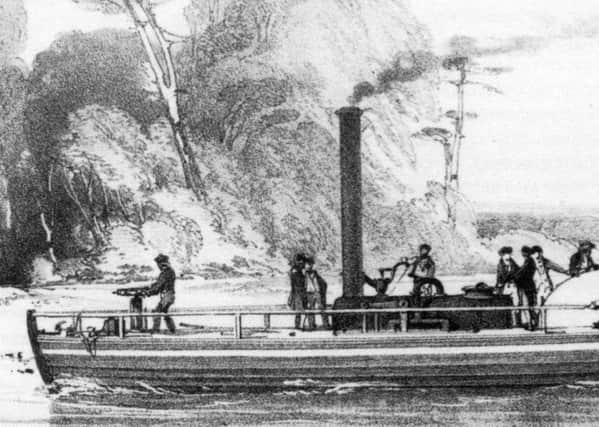Committed friends group steaming ahead with canal heritage trail


For the last few years the six-member strong Friends of the Charlotte Dundas have been trying to ensure the major achievement of the world’s first working paddle steamer, created in Grangemouth by William Symington in 1802, is acknowledged and preserved for generations to come.
Now the Charlotte Dundas Heritage Trail is only a matter of weeks away from completion.
Advertisement
Hide AdAdvertisement
Hide AdStretching from the Kelpies and Helix Park along the Forth and Clyde Canal to Lock One and Dalgrain Road in Grangemouth’s Old Town where the canal meets the River Carron, the trail features circular canal paths with interpretation panels, seating, signage and a landscaped space.
Friends of the Charlotte Dundas treasurer Douglas Peters said: “We were hoping to have the trail finished and ready for May, but it looks like it will now be opening in June and we will have an opening ceremony to mark the occasion.”
Ever since it first formed in Grangemouth back in 2013, Friends of the Charlotte Dundas has been on a mission to raise awareness of – and create a lasting memorial to – the world’s first practical steamboat and its creator.
The group initially tried to bring back the replica of the Charlotte Dundas which was located up in Arbroath. However, bringing it back to this area was a logistical nightmare, and that plan, like the replica itself, has now been scrapped.
Advertisement
Hide AdAdvertisement
Hide AdOver the years the group has been lucky enough to secure funding and assistance from a variety of sources, including Awards for All Scotland, EB Scotland, Earlsgate Property Investments, Falkirk Council, Forth Ports and Foundation Scotland.
The whole project has cost around £70,000 and there is now a bit of a funding shortfall with the group requiring another £10,000 to see it through to completion. Douglas said: “We could do with a bit more funding and some more people on the ground to help us with the tasks and work still to be done.”
Last year Friends of the Charlotte Dundas chairman Ken Hutton said: “It’s been our dream for many years to see a great Scottish engineer honoured near the place of his most important achievement.
“It has taken hard work and patience but that makes this all the more satisfying.”
Advertisement
Hide AdAdvertisement
Hide AdThanks to sturdy, long lasting display panels, people walking along the canal will be able to learn all about William Symington and his historic creation.
Symington was born in 1763 in Leadhills, a remote mining village in Lanarkshire. On leaving school he worked as an engineer and by the age of 24 had built a model steam carriage and designed his own improved atmospheric engine.
In 1788, when asked by Patrick Miller of Dalswinton House near Dumfries to fit a steam engine to a boat to drive the paddlewheels he adapted his steam carriage engine and the boat was tested on Dalswinton Loch.
Miller suggested he go to the Carron Company ironworks to design a more powerful engine for a larger boat called Experiment. Trials took place in 1789 and, although satisfactory, Miller withdrew his support.
Advertisement
Hide AdAdvertisement
Hide AdSymington went back to working on stationary engines, building over 20 between 1790 and 1800.
He became consulting engineer at the Carron Company, bringing in numerous orders to the works, where he was held in very high regard. Many engines were built to his design, including three for James Bruce, “the Abyssinian traveller”, of Kinnaird estate near Larbert.
Symington took up residence at Kinnaird managing the colliery after Bruce died in 1794, then moved to William Cadell’s Grange Colliery near Bo’ness.
In 1800, Sir Thomas Dundas, governor of the Forth and Clyde Canal Company, asked Symington to build a steamboat for use on the canal. The vessel was named Charlotte Dundas after Lord Dundas’s daughter.
Advertisement
Hide AdAdvertisement
Hide AdIt was 56 feet long by 18 feet wide and propelled by a 10 horsepower engine linked to a paddle wheel. Its “maiden voyage” took place on the Forth and Clyde Canal in Glasgow on January 4, 1803, with Lord Dundas and a few of his relatives and friends on board.
After some improvements, in March 1803, the Charlotte Dundas towed two 70-ton barges 19 miles along the Forth and Clyde Canal to Glasgow, taking nine and a quarter hours and demonstrating the practicality of steam power for towing boats.
After the Charlotte Dundas trials were halted, Symington became manager at Falkirk’s Callendar Colliery.
He lived to see others profit from his creative brilliance, dying in relative poverty in London in 1831, but his achievements remain and the Friends of the Charlotte Dundas would like to see him mentioned in the same breath as Scottish engineering pioneers like James Watt and William Murdoch.
Advertisement
Hide AdAdvertisement
Hide AdThe trail will do much more than just commemorate Symington and his vessel, however, it also aims to relate the history of the rich industrial and cultural heritage associated with the canal and give information on the kind of wildlife which currently calls the location home.
Visit www.charlotte-dundas.co.uk for information and, if you can help the Friends of the Charlotte Dundas with funding or assistance you can contact Ken on 07854852813.